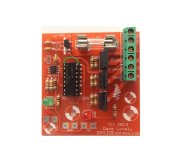Hi, I'm a long time lurker, first time poster. I realize this thread is almost a year old, but I just stumbled on it and I feel it is worth a bump because I really like the idea. I think this device has so much potential that I'm breaking my silence to resurrect this topic.

I'm definitely adding some of these to my pre-order. But all my outdoor strings will be 12v (longer distance, less power injection).
Dave, can you please let me know what the resistor swap needs to be in order to run these on 12v pixel strings. I understand why the 2811 power resistor needs to be changed but I'm a little baffled why the signal LED resistor needs to be changed. I thought ALL pixel strings run 5v on the data line even if the power line is 12v. Isn't the signal LED on the data line? FYI, I'll be using an E682 pixel controller if that makes a difference.
I think this device could be extremely useful but probably misunderstood by many. I think there would be more interest in this device if more people understand how it fits in. Any maybe even a desire to have a 2801 (or other) version. As more people move toward more pixel controllers I think this will become more clear.
Here is my plain-English description of what it is/does (please correct me if I'm wrong): :blush2:
1. This device takes the place of one pixel (3-channels) in a 2811 pixel string. Its just another "pixel" in the string.
2. It can be wired anywhere in the string (first, middle, last, does not matter) that any other pixel would fit.
3. Primarily used to add RGB "dumb" strings or RGB floods to an existing RGB "smart" string or pixel string controller.
A few obvious uses I see (and I intend to implement in my setup):
1. Connect an RGB star to a pixel megatree simply by adding this controller to the end of one of the pixel strings. The star would be controlled as another pixel on the string.
2. Connect vertical RGB dumb strips on chimneys (or downspouts or house corners) in the middle of pixel strings that run horizontally across a roofline.
3. Connect RGB floods on the ground between strings of pixel leaping arches.
4. Connect/control multiple RGB floods as though there were a pixel string
Also it could be use in place of a null node to open up new possibilities. Depending on your situation and where you have null nodes, you might put in this instead and add an RGB strip or flood or strobe or just some single-color LED strings and control it just like another pixel on the string.
Very Cool! :biggrin:

